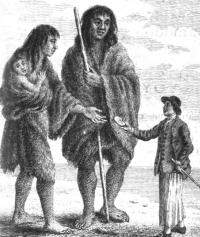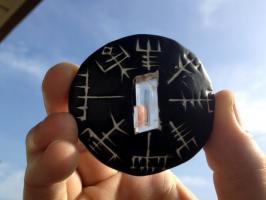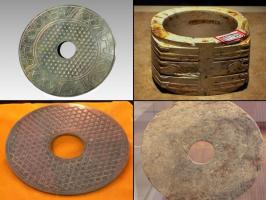The Giants of the Stones of Ica
The engravings on the famous Peruvian artefacts show astonishing technologies by men who would seem to depict a population of giants who clashed with the dinosaurs.


We have already discussed the topic of the Ica stones in another article, focusing on the dinosaurs depicted on them; now we want to return to the subject because we believe there is still much to say about these mysterious andesite stones and much more to analyze. If, as we believe, these objects are truly ancient, they could have been engraved with technological tools by an enigmatic people who lived in very remote times, given the content of the drawings and the hardness of the material, which can hardly be carved with simple metal tools; indeed, it is on this people that we want to focus our attention.
Thousands of engraved stones have been found in the Ica Valley, with the artifacts varying in size from small pebbles weighing about 20 grams to enormous boulders weighing half a ton. What is depicted is truly astonishing: aside from the already astounding matter of scenes showing dinosaurs interacting with humans, which suggests that an unknown lineage of advanced humans lived on Earth at the time of the dinosaurs, if this were the case, the origin of humanity is older than we think, and it is probably inferred that these humans were giants.

Moreover, the drawings of various scenes depicted on the stones suggest that these people had extensive scientific knowledge and were therefore capable of using technologies even more advanced than those of today. We understand that, in the eyes of a scientist and the general public, this might seem like science fiction; but if we carefully consider the various details of the entire matter, it might not seem like science fiction at all. In fact, official archaeology firmly denies that the Ica stones could be artifacts thousands or possibly millions of years old. Consequently, whenever the Ica stones are mentioned in any text, they are always referred to as blatant forgeries without ever taking the trouble to study them closely and seriously. Even if they were forgeries, science would still continue to deny their authenticity at all costs.
One of the reasons the stones are considered fake is that some were found inside ancient tombs dating back several thousand years. However, this does not mean that they could not be much older. They might have been considered cult objects by the ancient populations living in the valley. Moreover, how could these ancient people have known the anatomy of dinosaurs when the first fossil discovery was only made at the end of the 1700s, or the complex surgical technologies, or even the flying machines depicted on some of the stones?
Local police claim that the stones were actually produced by a couple of farmers to sell to tourists. As we mentioned in the article "Did Man Live with Dinosaurs?", such work done on fifty thousand stones would be practically impossible for two people to accomplish, even working twenty-four hours a day. Furthermore, the surgical operations and technologies are too complex to have been drawn by the two farmers, who turned out to be semi-literate. Additionally, the two were tested by having them engrave some designs on stones with the same composition as the Ica stones, but, as expected, these were not remotely comparable to the originals, either in content or in the quality of the engraving grooves.

If the stones were truly fake, how can we explain the fact that oxidation traces, a layer of grime that accumulates over thousands of years, are present both on the unengraved dark parts and the lighter worked parts? It is evident that the oxidation process began at the time the stones were carved, which cannot be artificially reproduced except through complex procedures achievable only in specialized laboratories.
It has been argued that those who engraved the stones did not consider proportions and perspective, as the humans appear too large compared to the dinosaurs. However, this raises a doubt: if these humans were so technologically advanced, why would they make such basic mistakes? On many of the artifacts, humans are shown riding stegosaurs, others riding extinct animals like five-toed llamas and horses, and still others being eaten by the same saurians. One man is even depicted cutting off the head of an apatosaurus. On one stone, there is even a depiction of a man performing a cesarean section on a dinosaur!
If the man was not a giant, how could he perform such an operation on an equally gigantic animal? Furthermore, the astonishing thing is that the fully formed baby can be seen in the beast's womb, not in an egg! This suggests that, contrary to what has been believed until now, dinosaurs were not just reptiles, but many of them were prehistoric mammals. In fact, some stones show an apatosaurus giving birth to live young like any common mammal, while another stone depicts a stegosaurus hatching from an egg as a kind of tadpole, suggesting they reproduced more like amphibians than reptiles.

Among the many technological knowledge areas depicted in the drawings, including botany, medicine, astronomy, and surgery, some even show men flying on a kind of mechanical bird, which might represent airplanes, and observing dinosaurs from above with a telescope, as other drawings demonstrate. From this, we can deduce that these men might be the same ones who traced the famous Nazca lines, visible only from above. Interestingly, the Ica Valley is near the Ocucaje and Nazca valleys, and the famous Colombian miniatures, which seem to depict ancient airplanes, could very well have been their aircraft.

Perhaps these same men drew the mysterious "Impossible Maps," which were also likely traced from great heights, as we explored in the article "Maps of the Pre-Glacial Era." Lastly, looking at the costumes and hairstyles of the figures engraved on the artifacts, we notice that they closely resemble those of Native Americans, Amazons, and Indo-European or Celtic peoples. All these cultures used to wear a headband and have long hair, except for the Celts, who only used the headband without feathers.
We can imagine that the men of the Ica stones preferred to leave their scientific teachings and messages engraved in understandable drawings rather than writing everything in a language that might have been impossible for us to decipher. Could these have been the giant gods described in various traditions, who passed on their knowledge to their descendants and to the civilizations that emerged after the Ice Ages, carving star maps on megaliths?

































